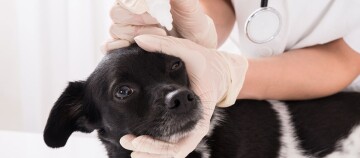Learn How to Massage Your Dog - for the Well-Being of Your Friend
07.10.2022 - Reading time: 4 minutes

Massage is a cultural and healing technique that has been used for thousands of years. It serves to relax and helps with tension and hardening of the musculature. In dog massage, the treatment techniques known and tested by humans are adapted to the anatomy of the animal. To ensure a good and healthy massage for your pet, you should use your hands in the best possible way. Find out here how you can quickly learn to massage your dog and treat him to a special wellness treatment.
When and why should you massage your dog?
Massage is a recognised treatment technique in physiotherapy. It probably has its roots in the Asian region. It can relieve pain in both humans and animals and make hard muscles supple again. In the case of neurological disorders of the musculature, for example if it is too slack, a massage can help to stimulate the nerves. Massage also improves your dog’s fitness in the case of musculoskeletal disorders.
Important: Please only massage after consultation and under the guidance of the vet!
Naturally, a massage will not harm a healthy dog either. It can help it to relax, for example, to overcome the stress of the big city, and it will strengthen the bond between you and your four-legged friend. If your dog is very active or runs a lot, it will appreciate a warm-up and relaxation massage of the muscles.
You should avoid giving massages if your dog is suffering from any of the following illnesses or impairments:
- Inflammation, fever or fresh injuries (in principle, in the case of painful conditions (acute or chronic) only after consultation with the vet)
- Pregnancy
- Tumours
- Cardiac disorders
- Infectious diseases
How do you detect tension in a dog?
Every dog owner develops an eye for and sense of the state of health of their pet. Under the professional guidance of a vet, you will learn to feel and detect muscular tension. Under no circumstances should you just go ahead and massage without any guidance, as this may cause a lot of damage.
First of all, the necessary preparation
Gently warm up your hands by rubbing them together. Feel your dog on both sides (possibly with eyes closed) to determine any differences in the musculature of the two halves of the body.
The most essential accessory for an optimal massage is a suitable base: a woollen blanket, yoga mat or a firm floor cushion. The pad should neither be too hard nor too soft; the dog should not “sag”.
Position your dog on the massage blanket and lower yourself to the dog’s height. Most dogs do not like it when people bend over them.
Dog massage points: the legs and paws
For a full body massage, start with the hind legs. Gently place your dog on one side; it should lie relaxed. You too should get into as relaxed a position as possible. Massage can only be done properly if you yourself are relaxed. You will notice that the massage can be meditative for you as well.
Look out for the following:
- Always stroke the hind legs from top to bottom.
- Massage in the direction of the fur.
- Apply gentle pressure to the muscles of the legs, but never to the bones. This can quickly become painful.
You may find that your dog pulls back its paw at first. But it will soon notice that the massage is pleasant. Do the same with its front legs.
You will soon learn to detect tension in your four-legged friend, especially in the muscles of the legs. Use a combination of stroking and light kneading of the muscles. Hand-over-hand strokes are optimal to loosen the dog’s muscles for the subsequent kneading.
Dog massage points: the back
After the hind and front legs, the neck and back come next. Note that a dog’s spine is very sensitive because there are a lot of nerves running under the skin. Never press directly on the spine.
Begin with the neck:
- Hold the fur of the neck and lift it slightly.
- Gently lower it back on the neck and repeat the process several times.
- Using the same method, work your way backwards along the side of the spine. Each area should only be massaged once.
Then carefully turn the animal to the other side. As far as possible, avoid rolling the dog over the sensitive spine. Repeat the procedure in the same order.
Each time you handle your dog, check to see if it raises its head, opens its eyes or pulls away parts of its body. If so, it might be feeling some discomfort.

You should consult a vet immediately if you find any unusual knotting or hardening under your dog’s skin during the massage.
Dog massage points: the head
The head should be the last part of the body to be massaged.
Look out for the following:
- To do this, place one hand under your four-legged friend’s muzzle.
- Now apply pressure to its forehead with your index and middle fingers in light circular movements.
- You can make smaller or larger circles and vary the pressure.
- Special attention should then be paid to the ears. Dogs are particularly sensitive there. Take one ear at a time in each hand. The ears should be kneaded very carefully and with only light pressure.
Similar to many massage techniques for humans, the final step involves stroking several times from the bridge of the nose over the forehead to the back of the neck. Here, the pressure may be increased again slightly.
Do not forget to reward your dog with a little treat at the end of the massage. That way, your dog will happily engage in the next wellness programme again.


